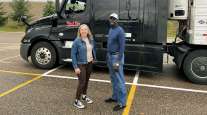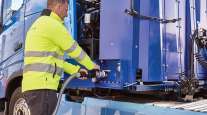Minnesota Awaits Result of National Push for Transportation Spending

WASHINGTON — President-elect Trump’s pledge to spend billions of dollars on new road and bridge projects could dramatically reshape Minnesota’s transportation priorities, potentially bringing private investment to finance massive public works projects.
In Minnesota and across the nation, elected leaders are scrambling to find ways to pay for road and bridge repairs, hampered by limited taxpayer dollars and stiff political resistance to raising the gasoline tax.
Even before he has taken office, Trump’s team has pitched a private investment model that would devote more than $100 billion in tax incentives to lure private businesses to invest in projects.
To recoup their investments, these projects would typically have a revenue stream attached — like a toll on roads or a fare to ride a train. This model could breathe new life into fledging projects like a proposed high-speed train from Minneapolis to Rochester, home of Mayo Clinic.
Transportation spending has for years bedeviled officials in Minnesota, where the list of backlogged projects has stretched into the billions of dollars.
Some political leaders are hopeful that transportation spending could be a rare area of accord among Democrats, Republicans and the new Trump administration.
“It’s a nonpartisan issue and it unites Democrats and Republicans,” said Charlie Weaver, executive director of the Minnesota Business Partnership.
RELATED: McConnell to Trump: tread carefully on infrastructure proposal
But some transportation advocates worry the private investment model won’t work in all cases, particularly in rural areas that need new wastewater plants or road repairs.
“If this is the be-all-end-all, it’s not going to be terribly helpful,” said Margaret Donahoe, who is executive director of the Minnesota Transportation Alliance. “It certainly wouldn’t help with greater Minnesota or help with the maintenance of roads and bridges we really need.”
A desire to direct money into roads, bridges and other infrastructure is among the few specifics known about Trump’s priorities after he gets sworn in January.
The appetite for new or better roads and bridges is endless. Congress passed a historic $305 billion highway bill last year and President Obama signed it. Of that, $4 billion went to Minnesota.
RELATED: Trump’s infrastructure plan dwarfed by estimates of need
In Minnesota, the pledge to maintain infrastructure carries some haunting historical baggage: In 2007, the Interstate 35W bridge collapsed during rush hour, killing 13 people and injuring 145.
Democrats Intrigued
The potential for more federal transportation spending has cracked Democrats’ nearly lockstep opposition to Trump and his administration.
Senate Minority Leader Chuck Schumer has signaled early willingness to work with Trump on a deal. Sen. Amy Klobuchar — known to seek common ground with political opponents — also expressed eagerness.
RELATED: Minnesota political battle holding up $105 million in FAST act funding
“I think it’s clear that a lot of people on both sides of the aisle have been trying to push for more infrastructure funding,” said Klobuchar (D-Minn.) “The devil is in the details. There are tons of highway projects that need to get finished.”
Sen. Al Franken was wary a Trump bill could be a giveaway to developers and builders — and he wonders how it will all get paid for.
“Things that lead to prosperity are infrastructure, education and innovation,” said Franken, (D-Minn.) “It’s really important to our global competitiveness. Obviously it’s all in the actual, how are you going to do that and what are you going to do?”
Fiscal Questions
How to pay for something this large — even if private investments were leading the way — is the largest question looming over the first glimpses of Trump’s plan.
The president-elect and the new Republican Congress could push a sweeping tax overhaul package that could usher new dollars into the treasury, money that would have to be pledged to highway projects.
Incoming U.S. Rep. Jason Lewis (R-Minn.) said he looks forward to some investment in roads and bridges — but is eager to hear more details.
“I don’t think there’s any question we need infrastructure improvements,” said Lewis, who takes office in January. “I think there are a lot of proposals out there, and I’ll wait until I see a bill.”
GOP Rep. Tom Emmer said he was not troubled by massive new transportation spending, even after some Republicans campaigned vowing to reduce budget deficits.
“It’s something our government is supposed to be involved in. This is the lifeblood of commerce in our country,” Emmer said. “I worry about the spending, but I also look at it in the bigger picture. … You need to keep in mind that we need economic growth that is 3, 4 and 5%. We have to start moving again and the way you do that is to repair and replace.”
Hennepin County Commissioner Peter McLaughlin remains hopeful, and he is optimistic that Trump’s evolving transportation spending plan could be a boon for Minnesota and other states.
“We’ve been fighting for this,” said McLaughlin, a Democrat and chairman of the National Association of Counties’ transportation committee.
After years of partisan gridlock between Obama and congressional Republicans, McLaughlin said he found it ironic to be so optimistic about “getting a big infrastructure bill with a Republican Congress and a Republican president.”




